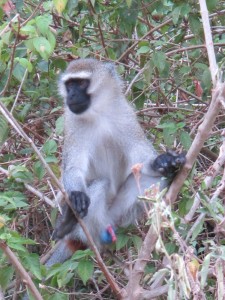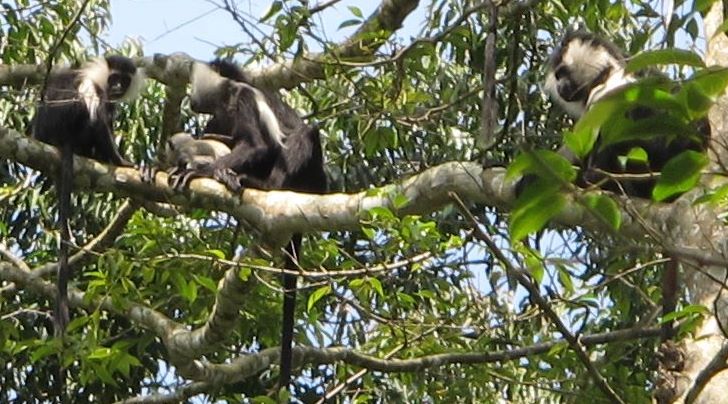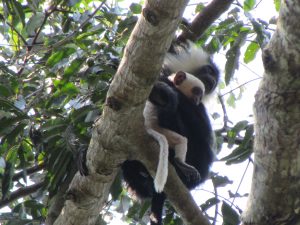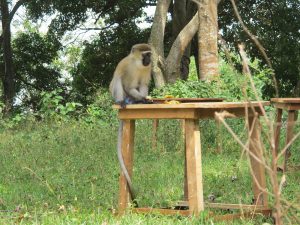 Foraging Decision-Making in Solitary & Social Primates
Foraging Decision-Making in Solitary & Social Primates
Animals are faced with a potentially over-whelming number of factors when foraging for food resources that differ in size, quality (energy available, rare nutrients, ease of digestion), distance, ease of access, predation risk, inducement of competition, etc. How they make quick decisions regarding which resources to visit is largely unknown. In our lab, we are utilizing foraging experiments to understand how wild animals find food, solve multi-destination routes with several resources, and decide what resources to visit first. In our study systems at Nabugabo, Uganda, and Kanchula, India individual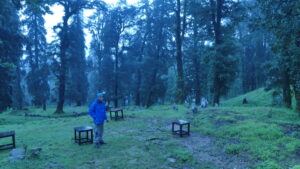 monkeys voluntarily leave their group to complete our experiments before returning and going through the experiment with others. This has allowed us to compare the same individuals for decisions made while solitary versus when social, showing different strategies in these situations based on dominance rank. We are collaborating with Dr. Chris Beck at the Toronto Intelligent Decision Engineering Laboratory at the University of Toronto (https://tidel.mie.utoronto.ca/beck.php) to design foraging arrays with optimization software to broadly expand this work to more species and field sites over the next few years.
monkeys voluntarily leave their group to complete our experiments before returning and going through the experiment with others. This has allowed us to compare the same individuals for decisions made while solitary versus when social, showing different strategies in these situations based on dominance rank. We are collaborating with Dr. Chris Beck at the Toronto Intelligent Decision Engineering Laboratory at the University of Toronto (https://tidel.mie.utoronto.ca/beck.php) to design foraging arrays with optimization software to broadly expand this work to more species and field sites over the next few years.
Photo credit: Virendra Mathur
Speed/Accuracy Trade-offs in Foraging Decisions
We are examining the impact of the social context on animal decision-making in several of our study systems. With COVID-19 pandemic and impossibility of travel for some time, we expanded our research to eastern gray squirrels (Sciurus carolinensis) on the UTSC campus. They turned out to be very willing participants in foraging experiments with plenty of competitive scenarios, given their home range overlap. In this video, an individual is successfully completing the “squirrel-plunk” with no competitors to contend with.
Movement Ecology in Vervet Monkeys and Himalayan Langurs
Animal movement research has blossomed in the last decade, benefiting from better methodologies and technologies. We are applying these new methods to better understand how vervet and langur groups are organized as they move through space, how they search for food resources, and how they deal with physical constraints posed by their environment. In the vervets, we are also examining pre-departure signals, who leads group progressions, how individuals garner support, and how success in leadership can change over the life history of an animal. In the langurs,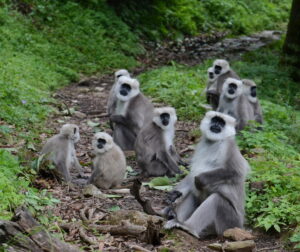 we are interested in how anthropogenic changes, such as deforestation, roads and agriculture, in the fertile valley bottoms of their mountainous range is impacting their movements. In some cases, these changes funnel the monkeys directly into areas of conflict with dogs and humans.
we are interested in how anthropogenic changes, such as deforestation, roads and agriculture, in the fertile valley bottoms of their mountainous range is impacting their movements. In some cases, these changes funnel the monkeys directly into areas of conflict with dogs and humans.
Photo credit: Virendra Mathur
Understanding the Social Structure of Rwenzori Angolan Colobus
We have determined that Colobus angolensis ruwenzorii at Nabugabo, Uganda are forming a multi-level society that is unique among primates in that about half the core units are uni-male/multi-female (OMUs) and half are multi-male/multi-female (MMUs). There are at least three tiers of social organization with core units clustering into clans that share a range in a band tier. These MMUs have several reproductive males that are socially integrated and that show bonding behaviours with one another. Our goals are to understand patterns of sex-biased dispersal in this species and determine the form of male relationships to understand how tolerant male relationships evolved. To do this, we are doing genetic analyses in collaboration with Dr. Eva Wikberg at the University of Texas San Antonio (https://evawikberg.com/). We are also working to understand the costs and benefits to females of living in different unit types. We are collaborating with Dr. Rudy Boonstra at the University of Toronto Scarborough (https://www.utsc.utoronto.ca/~boonstra/) to investigate the underlying hormonal patterns in maternal strategies and male bonding. This work will allow a greater understanding the larger impacts of ecological constraints and the strategies of group mates on the evolution of primate social systems.
Male-Infant Interactions in Rwenzori Angolan Colobus
C. a. ruwnenzorii show male natal attraction and infant handling at far higher rates than those seen in congeners. All males in core units handle infants and pass infants from male to male during display behaviours. We are working on understanding why these interactions are so common and how they evolved.
Photo credit: Sam Stead
Mechanisms Underlying Social Buffering in Ring-tailed Lemurs
 Group living has several benefits to individual health and longevity. Indeed, within groups, those that are most socially connected have been shown to often be less stressed, have better reproductive success, and live longer. This effect is known as “social buffering” and it is thought that it is due to the action of oxytocin (i.e., the bonding hormone) buffering rises in cortisol (i.e., the stress hormone) or facilitating a faster recovery from cortisol in these socially connected individuals. Tamara Kumpan and I are working in collaboration with Dr. Christine Drea (https://evolutionaryanthropology.duke.edu/people/christine-m-drea) to understand social buffering mechanisms occurring in ring-tailed lemurs at the Duke Lemur Center. This project will shed light on the physiology of the social buffering mechanism and the benefits that led to gregariousness and social bonding in so many primate species.
Group living has several benefits to individual health and longevity. Indeed, within groups, those that are most socially connected have been shown to often be less stressed, have better reproductive success, and live longer. This effect is known as “social buffering” and it is thought that it is due to the action of oxytocin (i.e., the bonding hormone) buffering rises in cortisol (i.e., the stress hormone) or facilitating a faster recovery from cortisol in these socially connected individuals. Tamara Kumpan and I are working in collaboration with Dr. Christine Drea (https://evolutionaryanthropology.duke.edu/people/christine-m-drea) to understand social buffering mechanisms occurring in ring-tailed lemurs at the Duke Lemur Center. This project will shed light on the physiology of the social buffering mechanism and the benefits that led to gregariousness and social bonding in so many primate species.
Photo credit: Tamara Kumpan
Male and Female Strategies Driving Social Organization in Ursine Colobus
During my MA at the University of Calgary under the supervision of Dr. James D. Paterson and my PhD with Dr. Pascale Sicotte (https://antharky.ucalgary.ca/sicotte/) I worked at the Boabeng-Fiema Monkey Sanctuary in Ghana where I studied social organization in ursine (or white-thighed) colobus (Colobus vellerosus). I contrasted ecological factors (i.e., range size, food availability, scramble competition for food) with social factors (i.e., infanticide risk, male sexual coercion, male advertisement, female mate choice) to explain variation in group size and group composition. I found that the rate of infanticide by immigrant males was high and that resident males often defended infants. While food competition constrained group size at the upper end of the continuum, infanticide risk played a more important role in determining social organization, limiting group size earlier and having more of an effect on group composition. Infanticide risk increased with female group size because immigrant males were attracted to larger female groups, thus females attempted to keep group size small by resisting female immigration, evicting maturing nulliparous females, and dispersing when groups became at risk for male takeover. Male qua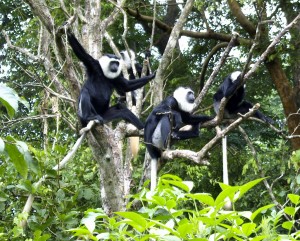 lity was found to be important to decreasing the risk of infanticide and females attempted to immigrate into groups where the male(s) won more encounters against the male(s) in the females’ own group. Within groups, male agonistic display output indicated fighting ability; however, males did not vary in their testosterone or parasite levels except when they dropped in rank and were involved in male-male fights. Females did not appear to use male agonistic display to inform their mate choices and seemed to mate promiscuously, perhaps as a counter-strategy to the high rates of infanticide.
lity was found to be important to decreasing the risk of infanticide and females attempted to immigrate into groups where the male(s) won more encounters against the male(s) in the females’ own group. Within groups, male agonistic display output indicated fighting ability; however, males did not vary in their testosterone or parasite levels except when they dropped in rank and were involved in male-male fights. Females did not appear to use male agonistic display to inform their mate choices and seemed to mate promiscuously, perhaps as a counter-strategy to the high rates of infanticide.

